Abstract
Blood lactate was measured 4-hourly in 21 newborn babies with respiratory distress syndrome, of whom 13 survived and 8 died. In general, lactate levels were higher in babies who died than in survivors, but there were inconsistencies which were uninterpretable if only a single estimation were made in a baby. Analysis of serial determinations showed that all patients in whom the lactate level never exceeded 35 mg/100 ml survived, and babies with high but falling values also did well. Only those who had rising lactate values, even if initially normal, died.
In most cases a high or normal Pao2 was associated with normal or decreasing lactate level; but babies with Pao2 below 60 mmHg had often also normal or decreasing lactate levels. Some babies had high and increasing lactate levels despite having normal Pao2.
In order to use lactate levels for prognosis in respiratory distress syndrome (RDS) serial determinations are required.
It is concluded that there may be a wide range of hypoxaemia without oxygen deficit in body tissues, so that it is not possible to define a `lower acceptable Pao2' which will define adequate tissue oxygenation.
Full text
PDF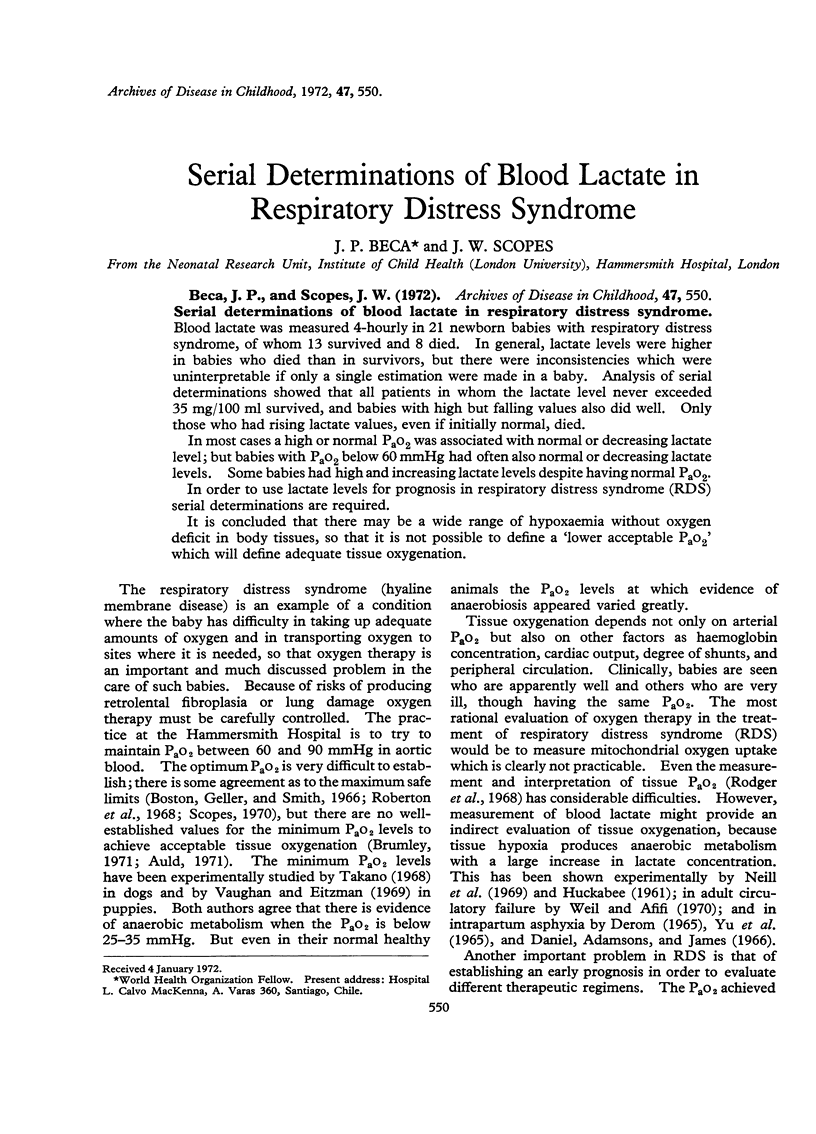
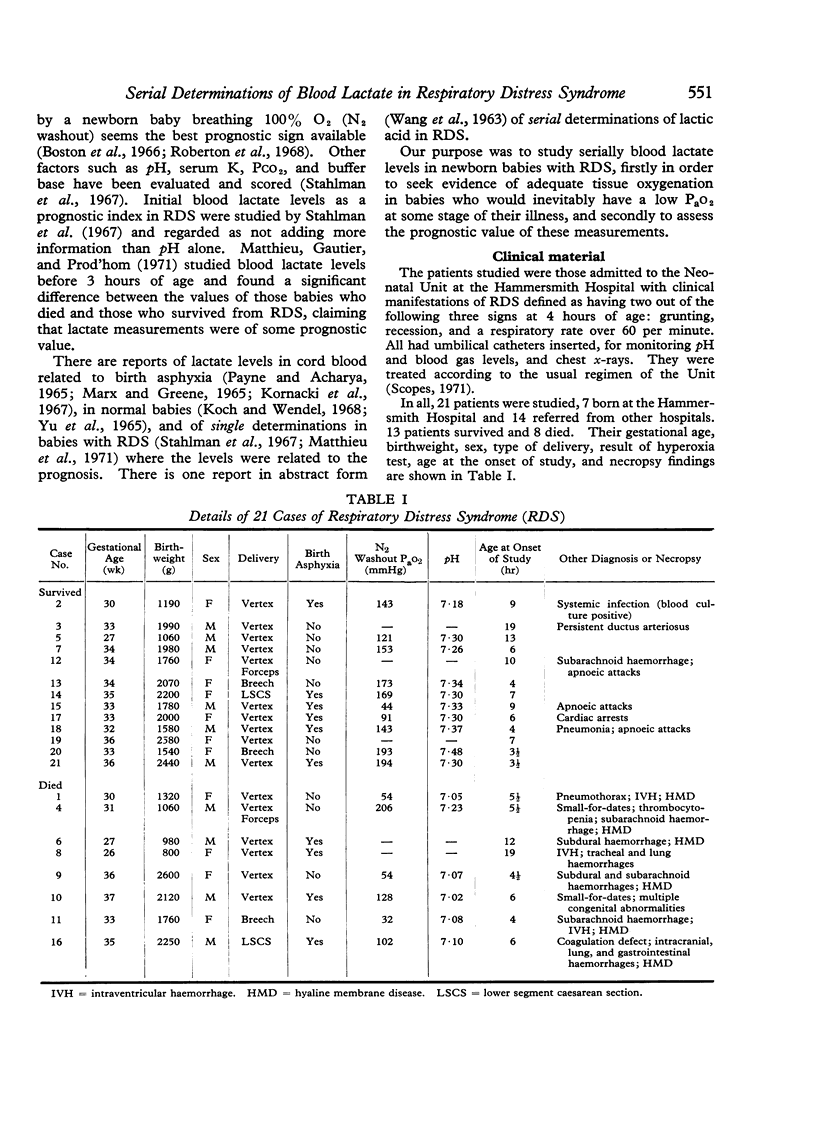
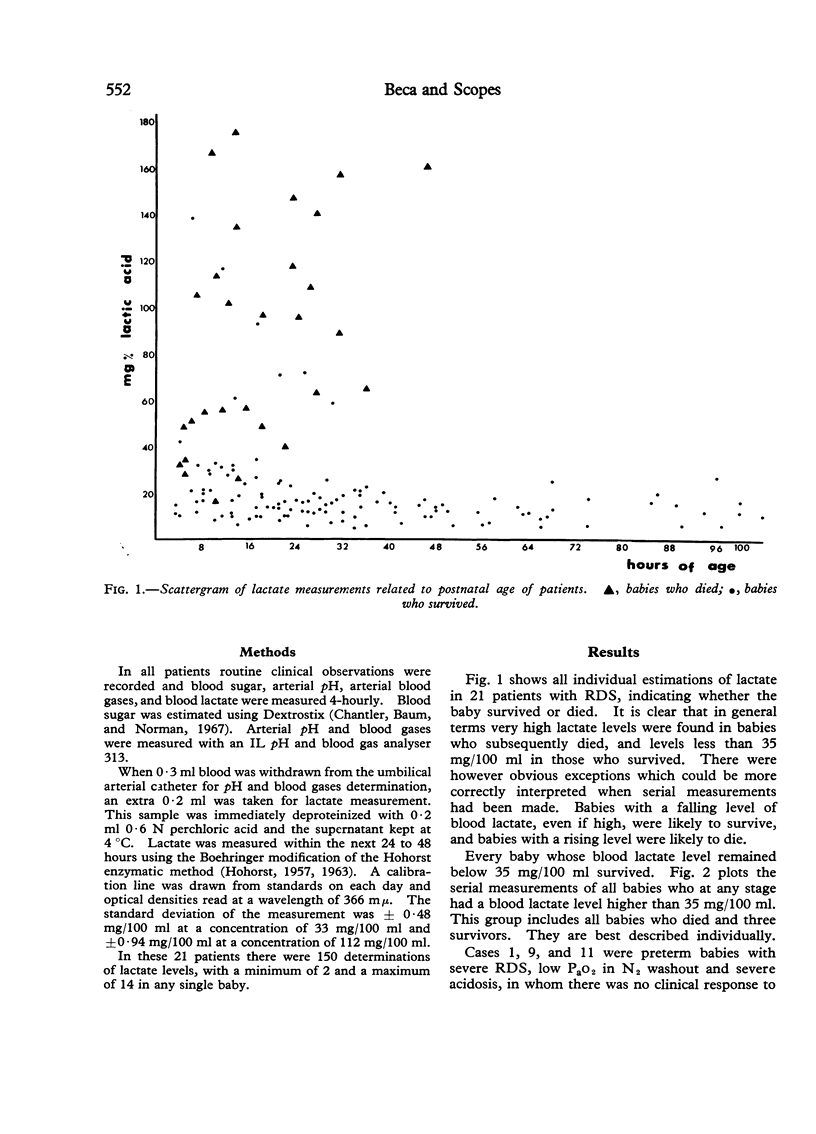
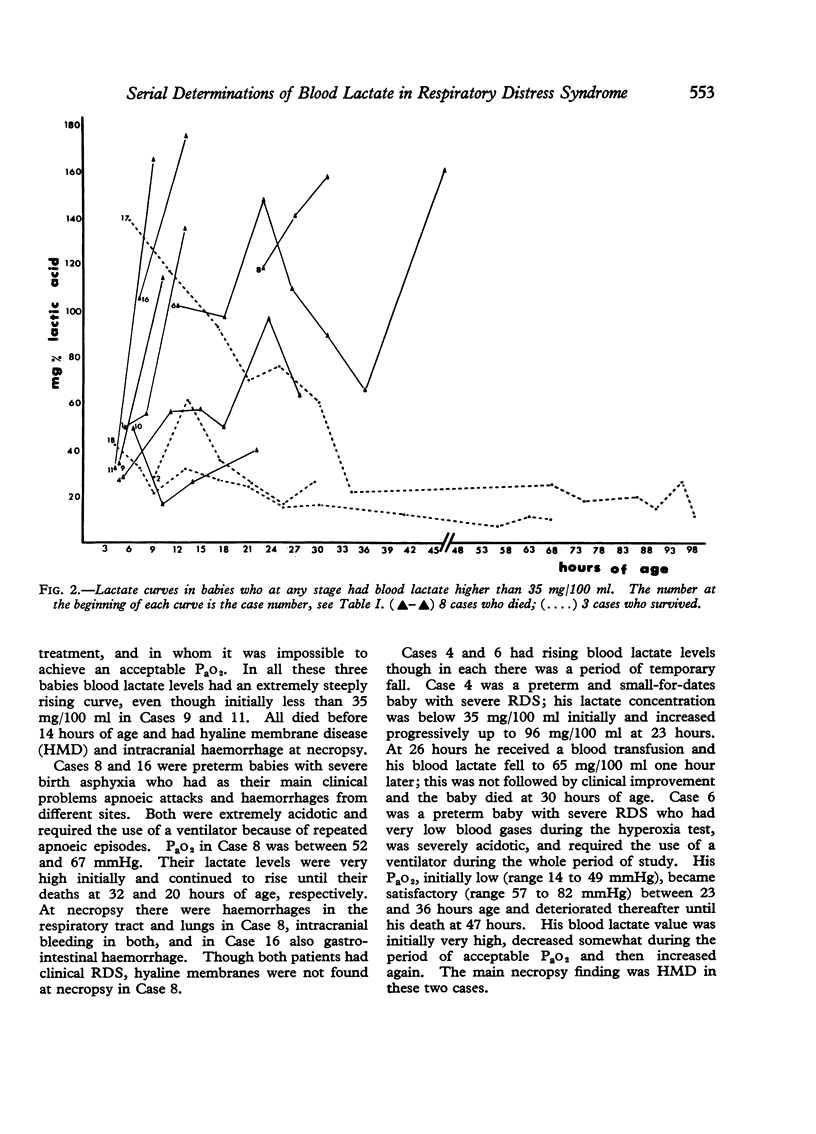
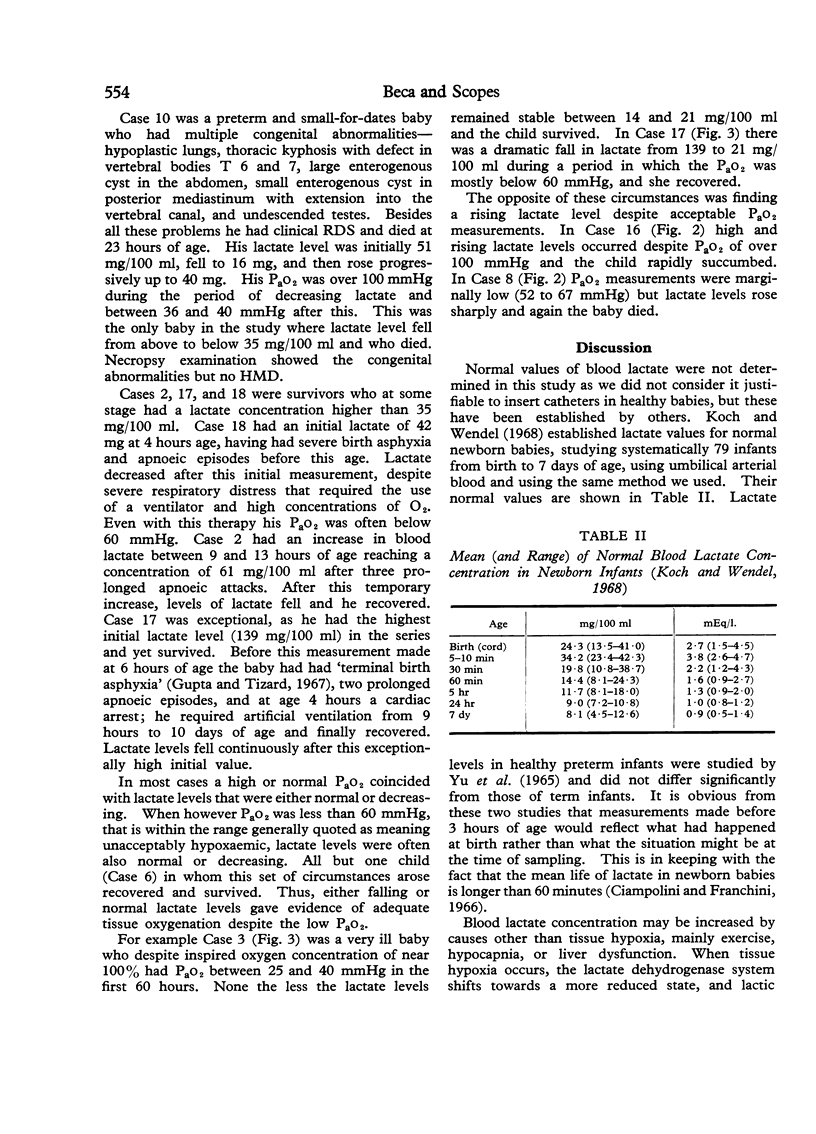



Selected References
These references are in PubMed. This may not be the complete list of references from this article.
- Alpert N. R. Lactate production and removal and the regulation of metabolism. Ann N Y Acad Sci. 1965 Jul 31;119(3):995–1012. doi: 10.1111/j.1749-6632.1965.tb47457.x. [DOI] [PubMed] [Google Scholar]
- Auld P. A. Oxygen therapy for premature infants. J Pediatr. 1971 Apr;78(4):705–709. doi: 10.1016/s0022-3476(71)80482-1. [DOI] [PubMed] [Google Scholar]
- Boston R. W., Geller F., Smith C. A. Arterial blood gas tensions and acid-base balance in the management of the respiratory distress syndrome. J Pediatr. 1966 Jan;68(1):74–89. doi: 10.1016/s0022-3476(66)80424-9. [DOI] [PubMed] [Google Scholar]
- Brumley G. W. The critically ill child: the respiratory distress syndrome of the newborn. Pediatrics. 1971 Apr;47(4):758–769. [PubMed] [Google Scholar]
- Cain S. M. Effect of PCO2 on the relation of lactate and excess lactate to O2 deficit. Am J Physiol. 1968 Jun;214(6):1322–1327. doi: 10.1152/ajplegacy.1968.214.6.1322. [DOI] [PubMed] [Google Scholar]
- Chantler C., Baum J. D., Norman D. A. Dextrostix in the diagnosis of neonatal hypoglycaemia. Lancet. 1967 Dec 30;2(7531):1395–1396. doi: 10.1016/s0140-6736(67)93026-7. [DOI] [PubMed] [Google Scholar]
- Ciampolini M., Franchini F. Modifications of lactate metabolism in the first month of life: intravenous loading tests of DL-lactate in premature newborn infants. Ann Paediatr. 1966;207(6):335–344. [PubMed] [Google Scholar]
- DEROM R. ANAEROBIC METABOLISM IN THE HUMAN FETUS. II. THE TWIN DELIVERY. Am J Obstet Gynecol. 1965 Jun 15;92:555–562. doi: 10.1016/s0002-9378(16)34849-9. [DOI] [PubMed] [Google Scholar]
- Daniel S. S., Adamsons K., Jr, James L. S. Lactate and pyruvate as an index of prenatal oxygen deprivation. Pediatrics. 1966 Jun;37(6):942–953. [PubMed] [Google Scholar]
- Gautier E. Lactic acidosis in infancy. Helv Med Acta. 1970 Dec;35(5):423–432. [PubMed] [Google Scholar]
- Gupta J. M., Tizard J. P. The sequence of events in neonatal apnoea. Lancet. 1967 Jul 8;2(7506):55–59. [PubMed] [Google Scholar]
- HOHORST H. J. Enzymatische Bestimmung von L(+)-Milchsäure. Biochem Z. 1957;328(7):509–521. [PubMed] [Google Scholar]
- HUCKABEE W. E. Relationships of pyruvate and lactate during anaerobic metabolism. I. Effects of infusion of pyruvate or glucose and of hyperventilation. J Clin Invest. 1958 Feb;37(2):244–254. doi: 10.1172/JCI103603. [DOI] [PMC free article] [PubMed] [Google Scholar]
- HUCKABEE W. E. Relationships of pyruvate and lactate during anaerobic metabolism. III. Effect of breathing low-oxygen gases. J Clin Invest. 1958 Feb;37(2):264–271. doi: 10.1172/JCI103605. [DOI] [PMC free article] [PubMed] [Google Scholar]
- Koch G., Wendel H. Adjustment of arterial blood gases and acid base balance in the normal newborn infant during the first week of life. Biol Neonat. 1968;12(3):136–161. doi: 10.1159/000240100. [DOI] [PubMed] [Google Scholar]
- MARX G. F., GREENE N. M. LACTATE/PYRUVATE RATIO OF UMBILICAL VEIN BLOOD. Am J Obstet Gynecol. 1965 Jun 15;92:548–554. doi: 10.1016/s0002-9378(16)34848-7. [DOI] [PubMed] [Google Scholar]
- Neill W. A., Jensen P. E., Rich G. B., Werschkul J. D. Effect of decreased O2 supply to tissue on the lactate: pyruvate ratio in blood. J Clin Invest. 1969 Oct;48(10):1862–1869. doi: 10.1172/JCI106152. [DOI] [PMC free article] [PubMed] [Google Scholar]
- OLSON R. E. "EXCESS LACTATE" AND ANAEROBIOSIS. Ann Intern Med. 1963 Dec;59:960–963. doi: 10.7326/0003-4819-59-6-960. [DOI] [PubMed] [Google Scholar]
- PAYNE W. W., ACHARYA P. T. THE EFFECT OF ABNORMAL BIRTH ON BLOOD CHEMISTRY DURING THE FIRST 48 HOURS OF LIFE. Arch Dis Child. 1965 Aug;40:436–441. doi: 10.1136/adc.40.212.436. [DOI] [PMC free article] [PubMed] [Google Scholar]
- Roberton N. R., Gupta J. M., Dahlenburg G. W., Tizard J. P. Oxygen therapy in the newborn. Lancet. 1968 Jun 22;1(7556):1323–1329. doi: 10.1016/s0140-6736(68)92033-3. [DOI] [PubMed] [Google Scholar]
- Rodger J. C., Kerr M. M., Richards I. D., Hutchison J. H. Measurements of oxygen tension in subcutaneous tissues of newborn infants under normobaric and hyperbaric conditions. Lancet. 1968 Aug 3;2(7562):232–236. doi: 10.1016/s0140-6736(68)92349-0. [DOI] [PubMed] [Google Scholar]
- Stahlman M. T., Battersby E. J., Shepard F. M., Blankenship W. J. Prognosis in hyaline-membrane disease. Use of a linear-discriminant. N Engl J Med. 1967 Feb 9;276(6):303–309. doi: 10.1056/NEJM196702092760601. [DOI] [PubMed] [Google Scholar]
- Takano N. Effect of CO2 on O2 transport, O2 uptake and blood lactate in hypoxia of anesthetized dog. Respir Physiol. 1970 Jul;10(1):38–50. doi: 10.1016/0034-5687(70)90025-3. [DOI] [PubMed] [Google Scholar]
- Takano N. Role of hypocapnia in the blood lactate accumulation during acute hypoxia. Respir Physiol. 1968 Jan;4(1):32–41. doi: 10.1016/0034-5687(68)90005-4. [DOI] [PubMed] [Google Scholar]
- Vaughan O., Eitzman D. V. Hypoxia and lactate in the newborn puppy. Biol Neonat. 1969;14(1):42–52. doi: 10.1159/000240168. [DOI] [PubMed] [Google Scholar]
- Weil M. H., Afifi A. A. Experimental and clinical studies on lactate and pyruvate as indicators of the severity of acute circulatory failure (shock). Circulation. 1970 Jun;41(6):989–1001. doi: 10.1161/01.cir.41.6.989. [DOI] [PubMed] [Google Scholar]
- Yu J., Payne W. W., Ifekwunigwe A., Stevens J. Biochemical status of healthy premature infants in the first 48 hours of life. Arch Dis Child. 1965 Oct;40(213):516–525. doi: 10.1136/adc.40.213.516. [DOI] [PMC free article] [PubMed] [Google Scholar]


